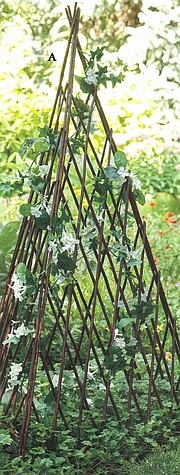Birds, raccoons, plant protection, pots as gardens
Today’s column will be a “catch-all” of information and ideas, brought about by personal experience in the realms of gardening and bird feeding. First and foremost is an answer to an email (to the Bee) regarding bird-feeding. The writer said she had tried everything to keep raccoons from her bird feeders, which were supported by trees near her house. No matter what she did or how she tried to protect the feeders, ‘coons got to them and tore them apart to get to the seeds.
My take on that problem is a reminder that raccoons climb trees. Feeders attached to a tree or hanging from branches are a piece of cake for those ravenous, pesky (but admittedly cute) creatures. “Been there, done that,” as the saying goes and learned some years ago that feeders hung from porch roofs or eaves were the only way to go. Raccoons can’t climb porch posts or hang from rafters and while they will avail themselves of spilled seeds on the porch or deck floor, that’s all they’re going to get.
There are other advantages to such locations – out of the rain or snow, away from bully birds like crows and easier replenishing as well. By the way, a current problem with salmonella in bird feeders has been reported and I have a suggestion for that as well. Don’t use wooden, plastic, or other solid-floored feeders. Protected or not, moisture gathers at the bottom to create mold and encourage disease. I have for many years used small loose-woven baskets with handles for my feeders, and with their better air circulation have never given me a problem. (Fingers crossed here!) Also, I don’t fill feeders to the brim, but instead, put out small amounts and replenish it throughout the day. Each morning before refilling, I toss any seeds remaining in the baskets onto the ground for scavengers and make sure the inside base is dry. A plus to this practical solution is that baskets look pretty – and a second (adorable) plus is that chickadees and nuthatches look so cute clinging to the sides of the baskets and pulling seeds out through the weave.
I recently “celebrated” my 91st birthday (how the heck did that ever happen!!) and with the acknowledgment of much more limited physical holdbacks – like kneeling, shoveling or even bending over for long periods – decided to put my huge pots to use as “kitchen gardens.” Whether you’re young, old or in between, they are a practical and attractive answer for tall, climbing or “shrubby” edibles. Consider tomatoes, peppers, eggplant, blueberries, rhubarb and other such pot-worthy fruit bearer/ornamentals such as raspberry-blackberry and many cultivars.
Don’t forget dwarf fruit trees. These include peaches, plums, cherries and apricots. There’s an enormous variety of choices for these small trees that range from those setting actual fruit such as the weeping cherry. Many of these do not set fruit, but blossom beautifully for the benefit of bees, hummingbirds and other pollinators.
For ornamental beauty, your big pots can host Hydrangea, Lavender, Dwarf Roses, and a host of other options. If you’re too busy to really garden, why not take the “high road” with big pots – for beauty and ease of care?
A final word on that score: Don’t buy plastic pots! Invest in good, heavy-duty ceramic pots with a drain hole, and when you place them (preferably on gravel), fill the bottom 1/4th with small rocks. Follow them with a bag of ordinary garden soil and top with the best planting soil available. Fill your pot to a few inches below the rim. Allow nature to take her course with rain and sunshine until planting time.
One of today’s illustrations is a plant pyramid that’s a winner in my book. It happens to be a replica of Thomas Jefferson’s personal plant protector/climber “teepees” that he used at the fabled Monticello gardens (which I have been fortunate enough to have visited). There are scores of plant holders available in nurseries and box stores everywhere, some resembling our picture, others created of wrought iron – such as plant pillars (also pictured), obelisks, and tuteurs – and some painted metal folded holders to self-assemble. I cannot even begin to discuss the latter. Suffice it to say I am NOT a do-it-yourselfer and the County dump now holds the results of my agonies. Maybe you can do better, but I’m going with the ready-made, ready-to-use teepees and pillar-types this year. They come in many different sizes so you can use them anywhere you need special but attractive support – such as peonies which always seem to bloom just before torrential rains. Too, the pillar-type holders can be used in our large pots – an extra bonus to help keep over-enthusiastic shrubs in check.
Here’s looking toward spring and a new garden season. See you next week. Valle Novak writes the Country Chef and Weekend Gardener columns for the Daily Bee. She can be reached at bcdailybee@bonnercountydailybee.com. or by phone at 208-265-4688 between the hours of 9 a.m. to 4 p.m.







